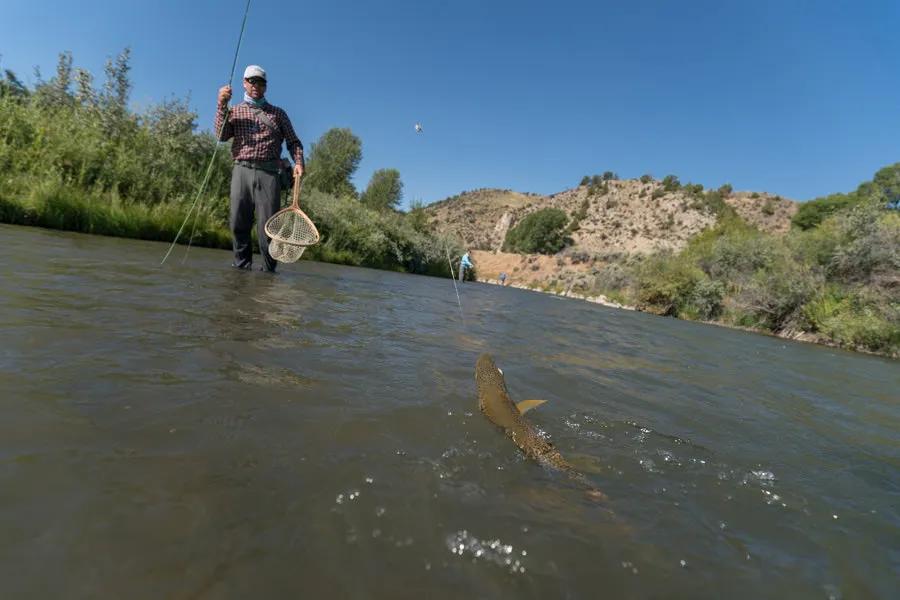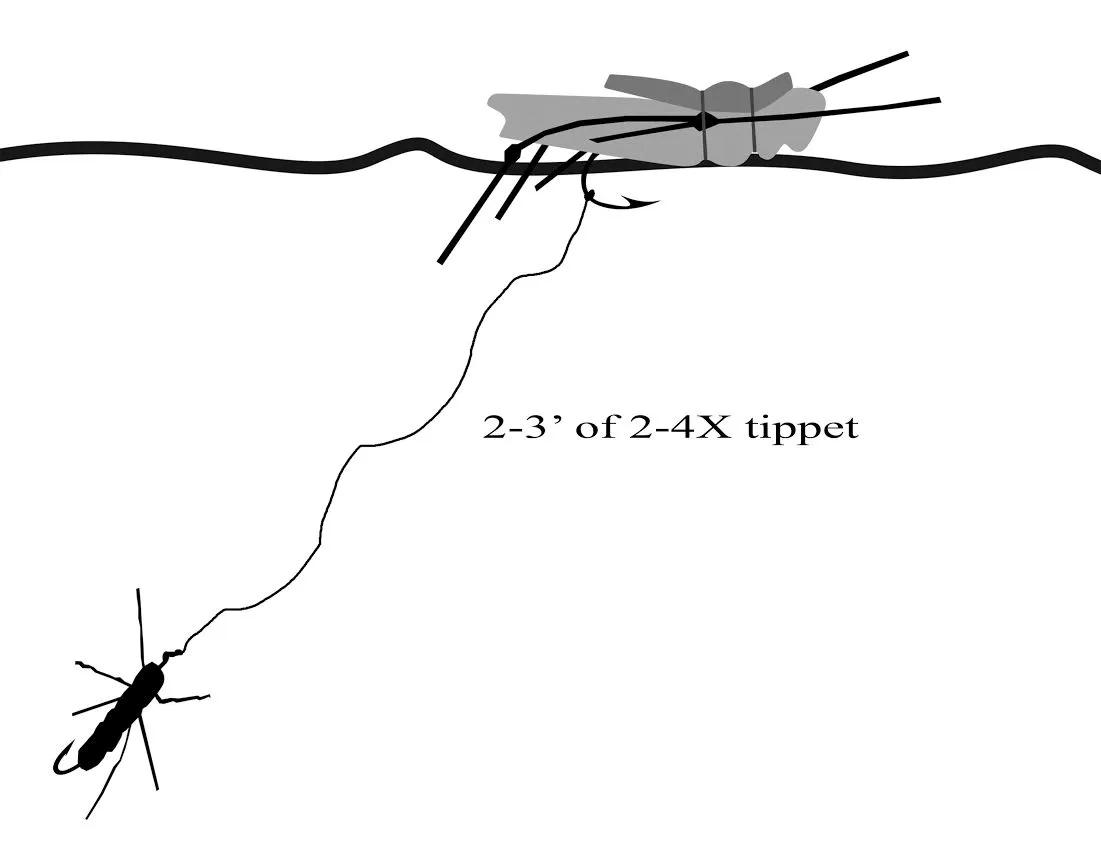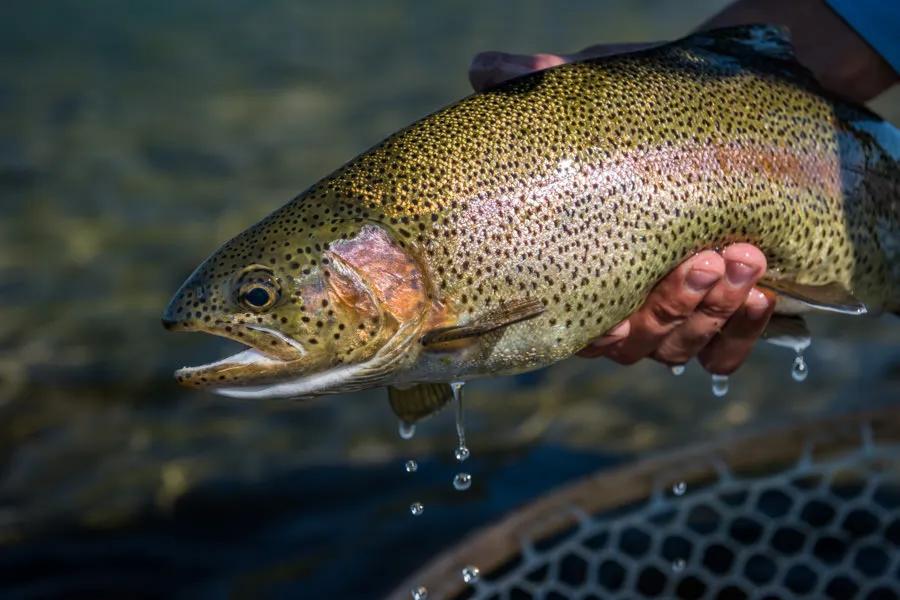
If you are in the process of planning your next fishing adventure to the fabled trout waters of southwestern Montana, you know there is a lot to think about. You’ll need to know which rivers have the hungriest fish, as well as what the fish will be feeding on. A savvy researcher can quickly learn the where, when, and what’s to increase productivity while trout fishing in Montana. With rivers like the Madison, Yellowstone, Missouri, and more, the fly fishing near Bozeman, Montana is ripe with diversity.
But, knowing where to fish, when to fish, and what flies to use are only part of the equation. It is also critical to know what techniques produce the best catch rates.
One of the most common techniques in trout fishing is the dry dropper technique. Also, known as a "Dry-Dropper" set up. This technique is effective because it enables the angler to ‘fish’ flies in two feeding zones: one fly on the surface river, and one fly below the surface. This sounds very simple, but there are a few tips for increasing the effectiveness of the dry-dropper technique.

Rigging a Dry-Dropper Set Up
The most common rigging for a dry-dropper set up is to tie on a large buoyant dry fly, one that imitates a grasshopper, cricket, stonefly, or other large insect. This will be the point fly or the "dry" fly portion of the dry dropper. Off the bend of the hook on the dry fly, tie on a heavy deep sinking nymph as the "dropper." You can also use this set up with smaller flies. A small dry fly, such as a size 16 Purple Haze with a size 18-20 WD40 dropped off the back can be a deadly combo during a mayfly hatch. Rising trout will focus on stage of the hatching mayfly, and a small dry dropper set up can bring on more strikes. The dry fly imitates the hatched adult mayfly just before it takes flight. The lightly weighted dropper imitates an emerging mayfly, as it struggles to reach the surface of the river. This is just one situation the dry dropper technique with shine, but be sure to adjust the set up for each situation.
When casting a classic Dry-Dropper set up, there are a few adjustments to make to increase the effectiveness and enjoyment while fishing. Trout are commonly aggressive to eat a grasshopper or stonefly, so you rarely need to worry about the size of the tippet. Most trout won’t be leader shy. A short, stout leader is the best choice for turning over the bigger flies. To create an easy casting rig, attach a nine foot 3X or 4X tapered leader to the fly line, then trim off 2-3 feet from the tapered end (be sure to save that extra piece of the leader).
Tie your hopper or stonefly to the newly created 6-7 foot leader. Some popular flies for southwest Montana are Chubby Chernobyls and Chernobyl Ants. On the bend of the hook of the dry fly, attach the extra piece of leader material using a clinch or modified clinch know. Then tie the dropper to the end. The set up should still be about 9 feet in length, with the big dry fly 6-7 feet from the end of the fly line, and the dropper 2-3 feet from the dry fly. This set up is much easier to cast than a big dry a full nine-foot leader, plus another couple of feet the dropper. As a bonus, your accuracy should improve too.

Leaders and Tippet Choice is Key
A big buoyant dry fly can be challenging to cast, especially with a heavily weighed fly off the back, so don’t be afraid to trim the length of your leader between the fly line and the dry fly. The shorter the distance between the fly line and the dry fly, the easier it will be to cast this set up. In some situations, you may need a longer distance between the dry fly and the dropper, that depends on how deep the fly needs to sink. If you increase the length between the dry fly and the dropper, it will be beneficial to shorten the distance between the fly line and the dry fly. Keeping the full length of the leader, dry fly, tippet, and dropper between 7-9 feet will make for the easiest set up to fish for Montana trout fly fishing.
When using the dry dropper technique with smaller flies you can increase the leader length. The smaller flies should be much easier to cast, even at leader lengths over 9 feet. An important consideration when fishing smaller dry dropper flies, is what the dropper is imitating. The distance between the dry and the dropper will change, depending on how the fly is being fished. If it is a nymph, the distance between the dry and dropper should be longer, giving the nymph time to sink deep into the water column. If the dropper is to be fished as an emerger, then a short distance between the dry and dropper imitate a nymph emerging into an adult insect.

Dry-Dropper is Effective Because it Works!
The Dry-Dropper set up can be found in nearly every guide's boat throughout Montana and the West. Why? Because it works! The set up works for multiple reasons: the big dry fly will attract strikes and at the same time act as a strike indicator. The set up also works well when using tiny dry flies too. In the fall, Tricos become an important food source for trout on many rivers in Montana. The tiny size of the flies like size 20-24 are difficult to see. Even a seasoned fishing guide will admit they have trouble seeing these flies. To be sure not to miss any strikes, guides will tie a bigger dry fly on the leader, then "drop" the micro flies off the back. The larger dry fly isn’t expected to catch the fish, rather it is used as an indicator. If you see the lead fly sink, twitch, or a rise near the indicator fly...SET THE HOOK!
Armed with the knowledge of what is hatching, where the hungriest fish swim, and how to best utilize the Dry-Dropper technique will give you the upper hand during your Montana fly fishing adventure.
For more information about the Dry-Dropper technique or any other fishing related topics, contact Montana Angler today.
